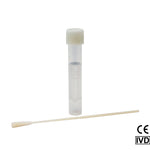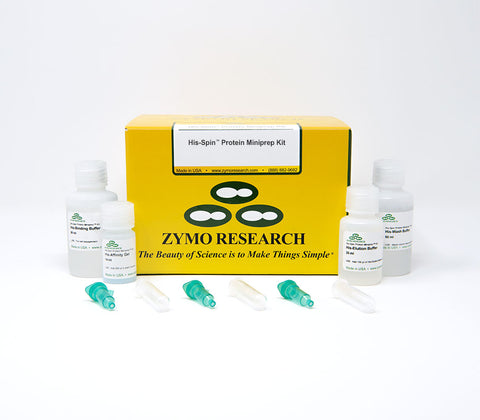Successfully Added to Cart
Customers also bought...
-
 DNA/RNA Shield (50 ml)Cat#: R1100-50DNA/RNA Shield reagent is a DNA and RNA stabilization solution for nucleic acids in any biological sample. This DNA and RNA stabilization solution preserves the...
DNA/RNA Shield (50 ml)Cat#: R1100-50DNA/RNA Shield reagent is a DNA and RNA stabilization solution for nucleic acids in any biological sample. This DNA and RNA stabilization solution preserves the... -
 DNA/RNA Shield SafeCollect Swab Collection Kit, 1ml (1 collection kit)Cat#: R1160The DNA/RNA Shield SafeCollect Swab Collection Kit is a user-friendly collection kit for stabilizing the nucleic acid content of samples collected with a swab. DNA/RNA Shield completely inactivates harmful pathogens...
DNA/RNA Shield SafeCollect Swab Collection Kit, 1ml (1 collection kit)Cat#: R1160The DNA/RNA Shield SafeCollect Swab Collection Kit is a user-friendly collection kit for stabilizing the nucleic acid content of samples collected with a swab. DNA/RNA Shield completely inactivates harmful pathogens...
His-Spin Protein Miniprep
| Cat # | Name | Size | Price | Quantity |
|---|
Highlights
- Fast: Purify His-tagged proteins from cell lysates in less than 5 minutes.
- Simple: Prepare pure protein for small-scale studies using a spin-column.
- Convenient: No special instrumentation needed other than a benchtop microcentrifuge.
Documents
Product Description
Technical Specifications
| Affinity Matrix | Nickel charged agarose |
|---|---|
| Binding Capacity | 1 mg |
| Elution Method | Imidazole gradient |
| Elution Volume | 100 - 200 µl (150 µl is optimal) |
| Principle of Technology | Based on a nickel-charged His-Affinity Gel (IMAC). |
| Processing Time | 5 minutes |
| Product Storage | Please store the His-Affinity Gel, His-Binding Buffer, His-Wash Buffer, and His-Elution Buffer at 4°C. The other components can be stored at room temperature. |
| Protein Purity | Electrophoretically pure. Purified high-quality protein is suitable for enzyme kinetics, protein biochemical analyses, SDS-PAGE, and other applications. |
| Required Equipment | Microcentrifuge |
| Sample Type | Cell lysates or other complex protein mixtures containing His-tagged proteins. |
Resources
Q1: Is the product suitable for eukaryotic expression system (HEK cells)?
Yes, the His-Spin Protein Miniprep Kit can also be used with eukaryotic expression systems. For references: Marcos J. Caballero-L´opez, Manuel Nieto-D´ıaz, M´onica Yunta, David Reigada, Teresa Mu˜noz-Galdeano, ´Angela del ´Aguila, Rosa Navarro-Ru´ız, Wolfang Pita-Thomas, Dan Lindholm, Rodrigo M. Maza - XIAP Interacts with and Regulates the Activity of FAF1 – 2017, BBA - Molecular Cell Research. doi:10.1016/j.bbamcr.2017.04.006
Q2: Can less than 100 µl of His-Elution Buffer be used for the elution step?
Smaller elution volumes are possible and may yield more concentrated protein, but the elution efficiency may be compromised.
Q3: What might reduce protein yields?
- The His-tag may be rendered inaccessible due to protein folding. The protein can be purified at denaturing conditions. - The recombinant protein can become insoluble as a result of overexpression. The protein can be purified at denaturing conditions. - Starting material is too dilute. If the starting material contains very low levels of His-tagged protein, then it may require more than 300 µl of sample volume to purify enough protein. Simply repeat steps 3 and 4 until the desired volume has been loaded onto the column. - The protein is bound to the His-Affinity Gel too tightly and can not be eluted with the supplied His-Elution Buffer. A custom-made elution buffer containing 500 mM imidazole or 100 mM EDTA may elute the tightly-bound protein. - Depending on the protein, lowering the imidazole concentration of the His-Wash Buffer to 25 mM (e.g., by dilution with His-Binding Buffer) may increase yields.
Q4: Which chemicals/reagents are not compatible with the kit?
EDTA, EGTA, DTT, > 15 mM Β-mercaptoethanol, and > 10 mM imidazole or histidine. If your starting material contains these compounds, dilution with the His-Binding Buffer may help. Multiple loadings on the column will be necessary to load enough material. If the sample is in a different buffer, adjust the pH and imidazole and salt concentrations and carry out a test preparation. If the protein is still not bound, the sample needs to be dialyzed before use.
Q5: How do you purify insoluble proteins?
- Optimize expression conditions. Overexpression of proteins may result in formation of insoluble inclusion bodies inside cells. If a large band of overexpressed protein is visible after SDS-PAGE electrophoresis of whole cells, but the band is absent after SDS-PAGE electrophoresis of cleared cell lysates, this indicates that the protein may not be soluble and the expressed protein may form inclusion bodies. - Use Denaturing conditions. Insoluble proteins will not be purified using the provided buffers. It is, however, possible to purify such proteins at denaturing conditions in the presence of ≤ 8 M urea or ≤ 6 M guanidine hydrochloride. The protein native structure and thus enzyme activity is lost under such conditions, but may be restored by refolding the protein after purification.
Q6: Can the kit be used to purify membrane proteins?
Membrane proteins can be purified after solubilization in a nonionic detergent. Concentrations of up to 2% of Triton® or TWEEN® can be present in the loaded sample.
Q7: Which pH should be used with the kit?
The pH value of the loaded sample should be between 7.5 and 8.0. Too high or low pH can result in decreased protein yields and/or quality.
Q8: How do you improve protein quality/purity?
- Check your buffers for signs of contamination and check the pH of the buffers. - Increase centrifugation time and speed. Ensure that the His-Affinity Gel drains completely after each spin (some older centrifuge models may require a longer centrifugation time). - If the problem persists, additional wash steps can be added to the purification protocol, or increasing the imidazole concentration of the washing buffer to 60 – 100 mM (e.g., by dilution with the His-Elution Buffer).
Q9: Is there a recommended lysis protocol?
Is there a recommended lysis protocol? For protein purification from E. coli lysates: 1. Harvest & pellet 10 ml of E. coli culture. 2. Resuspend in 1 ml of His-Binding Buffer. 3. Lyse the cells by sonication (or other methods). 4. Spin at ≥ 12,000 x g at 4°C for 5 minutes. 5. Use 150 µl of the supernatant for the His-Spin Protein Miniprep protocol.
Q10: Which chemicals/reagents are compatible with the kit?
Reducing Agents ≤ 15 mM β-mercaptoethanol Non-Ionic Detergents ≤ 2% Nonidet® P-40 ≤ 2% Triton® X-100 ≤ 2% Tween®-20 Denaturing Reagents ≤ 8 M Urea Chemicals and other Reagents ≤ 10 mM Imidazole ≤ 10 mM Histidine
| Cat # | Name | Size | Price | |
|---|---|---|---|---|
| P2003-2 | His-Affinity Gel | 14 ml | $221.80 | |
| P2003-3 | His-Binding Buffer | 50 ml | $29.10 | |
| P2003-4 | His-Wash Buffer | 50 ml | $31.50 | |
| P2003-5 | His-Elution Buffer | 25 ml | $37.40 | |
| C1001-50 | Collection Tubes | 50 Pack | $17.50 | |
| P2003-1 | Zymo-Spin P1 Columns | 50 Pack | $51.40 | |
Need help? Contact Us


